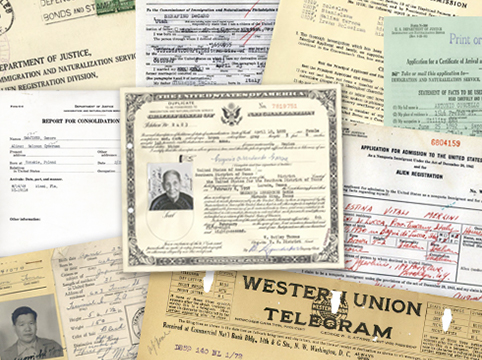A-Files Image Gallery
A-Files, were opened or consolidated for every immigrant who arrived after April 1, 1944, or who naturalized after April 1, 1956. Immigrants who naturalized between 1944 and 1956 should not have an A-File. In 2010 USCIS began the process of transferring A-Files of immigrants born more than 100 years ago to the National Archives. The vast majority of A-Files remain in USCIS custody.

The foundation document of most A-Files is an immigrant visa and alien registration. Visa and registration forms vary by date and class of admission. This illustration features a post-WW II War Bride visa.
If an immigrant’s relatives petitioned for their visa, their A-File should contain the petition and supporting documents.
Immigrants who arrived prior to 1944, but for whom an A-File was later created, will often have an original copy of their AR-2 registration form in their A-File.
If an immigrant was classified as an Enemy Alien in World War II, records of their Enemy Alien status should be found in their A-File.
Consolidated A-Files include a report of the search for all other agency records of the immigrant. The report indicates what prior records were consolidated into the A-File.
A-Files of immigrants admitted as refugees typically hold documents created under specific refugee legislation.
In the 1940’s registered aliens were required to report any change of address using a post-card form. After 1950 they had to report their address every January whether or not the address changed. A-Files may contain one or more of these post-cards among various documents.
Immigrants naturalized after March 31, 1956 had all their naturalization documents filed in their A-File. These include the extensive Application to File a Petition for Naturalization which includes complete biographical information.
Immigrants naturalized after March 31, 1956 had all their naturalization documents filed in their A-File, including a duplicate copy of the certificate of naturalization (naturalization documents dated prior to 4/01/1956 see C-Files).
A-File content is as unique as the individual it represents. They may have only a few pages or contain 100’s of pages in multiple folders. Like other USCIS files, A-File content depends on the history of interaction between the immigrant and the agency.

